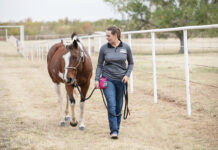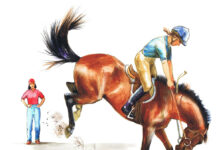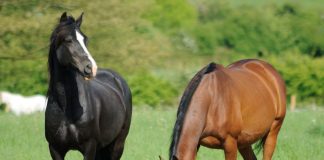You’ve been horse shopping for a while, looking for that perfect partner. Well, you’ve finally found him—and he sailed through his pre-purchase exam with flying colors! While that might seem like the hard part, now is when you really have to get organized and do your homework. Read on to learn what you need to have before buying or adopting a new horse!
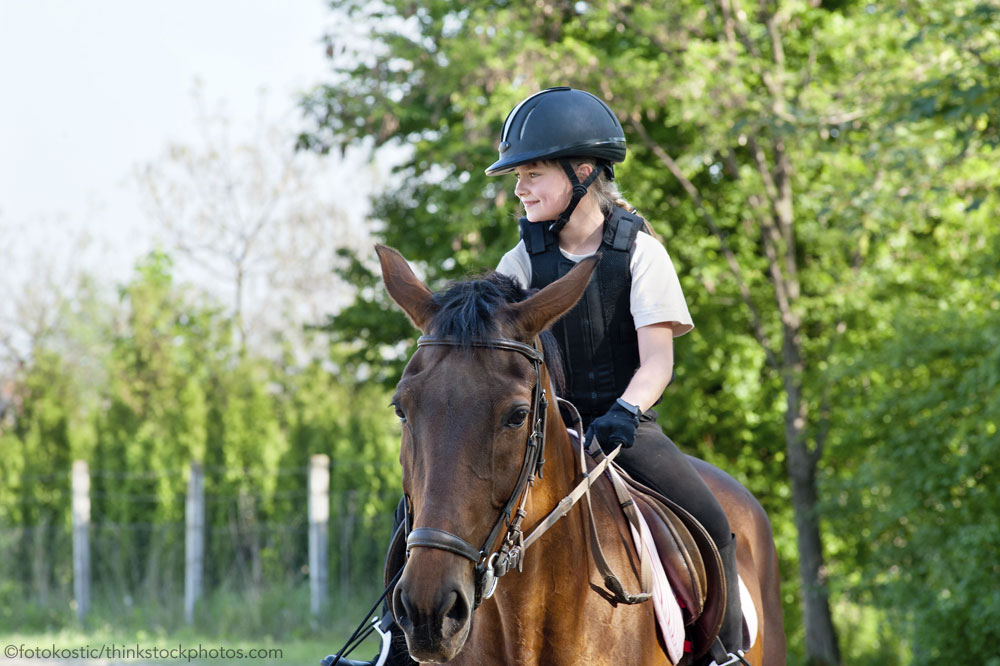
Home Sweet Home
Before buying or adopting a new horse, first things first. Where will your horse live? You will either need to find a boarding barn, or if you plan on keeping the horse at home (or the home of a friend or family member), make sure the facilities are safe and have everything your horse needs.
Boarding can have several upsides, such as knowing someone is taking care of your horse if you go out of town or get busy with school some days. You can meet new friends and have other people to ride with. Also, you won’t be unloading hay or fixing fences on weekends.
If you prefer home horsekeeping, you’ll have the advantage of managing your horse’s feed and turnout schedule exactly the way you like it. However, the facilities may not be as fancy (multiple arenas, jumps, et cetera) and you are responsible for all of your horse’s care.
If you decide to board, ask your friends for recommendations and carefully inspect the facility. It should have safe fencing (no barbed wire!) and look neat and tidy, with clean stalls and water buckets or troughs full of fresh water. The horses on the property should all look healthy and well-fed.
If bringing your horse home, make sure all of the fencing is safe and strong and your horse has a run-in shed for protection from the elements in his turnout field. You will also need a place for storing tack and feed, a flat place to ride, and a covered location for storing hay. Grain needs to be stored securely in a latching bin in a place where horses can’t get into it. Overindulging on rich grain can cause colic, laminitis and other very serious problems.
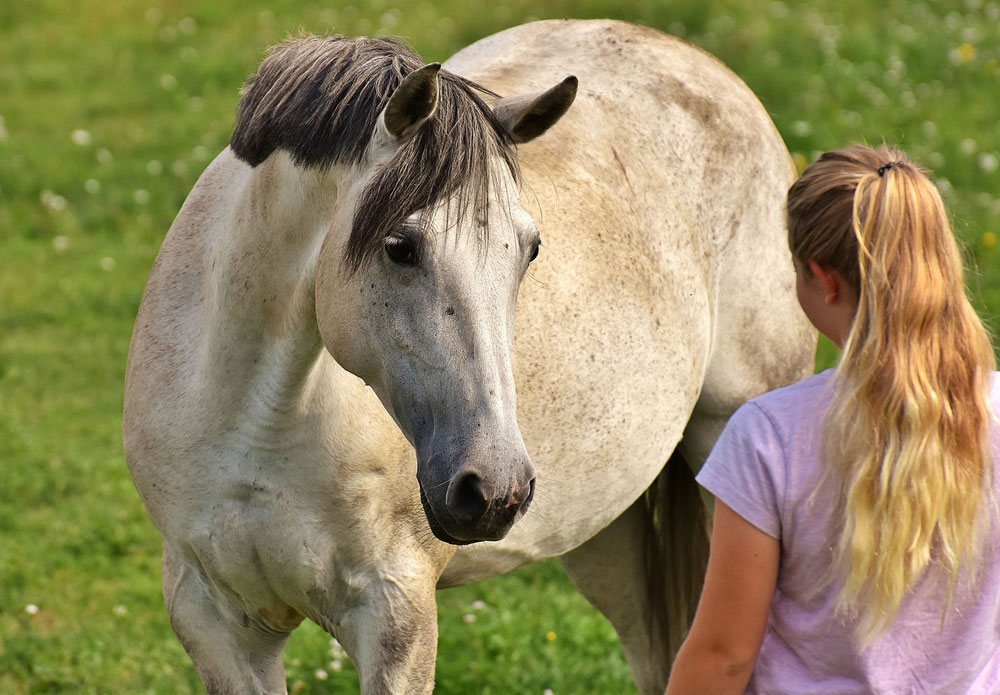
The Need for Feed
Before buying or adopting your new horse and picking him up, ask what he is currently eating. Does he get any grain or sweet feed? Alfalfa or grass hay? It’s very important not to suddenly change a horse’s diet because it can cause him to colic.
If you will be switching your horse to a different type of hay or grain, do so gradually. Spend at least a week giving him 50 percent of his old food and 50 percent of his new food. This allows his body to adjust instead of having a sudden shock.
Most boarding barns feed standard amounts of hay and grain, but don’t be afraid to tell the barn owner if your horse has special dietary needs (such as no grain or a certain type of feed). A good barn will want to keep your horse healthy like you do!
Vet & Farrier
You’ll also want to have a vet and farrier lined up to keep your new horse healthy. Ask your horsey friends in the area or others at your boarding barn who they use. Many equestrian areas have a vet hospital that can send out a vet on short notice, so put that phone number on your speed dial.
Also ask who your barn or friends use for shoeing. Find out if the price is within your budget and make sure to meet the farrier the first time he shoes or trims your horse so you can see how he treats the horse.
A Good Teacher
Plan on taking riding lessons with your new horse so that you can keep improving your skills and work through any training problems that arise as you get to know each other.
Stable Supplies
Now comes the fun part. Before picking up your new horse, take a trip to the tack store! Start with a halter and lead rope. You’ll also need a basic grooming kit: curry comb, hard brush, soft brush, hoof pick, mane and tail brush, sweat scraper and a tote to keep it in.
Extra items you may need include fly spray, a fly mask, shampoo and detangler. It’s also time to put together a simple first-aid kit including a thermometer, antiseptic wound cleanser and treatment, and bandaging materials.
Find out what kind of bit your horse goes best in, and what size, and buy the same type. Most horses can be ridden in a gentle snaffle of some type. Get a properly fitted bridle, as well as a girth or cinch and saddle pad.
If you are going to use a saddle you already own, make sure your trainer or a knowledgeable saddle fitter checks it out on your new horse before riding off into the sunset. If it pinches, rocks, or rubs, your horse could become back sore for a long time. (Check out “If the Saddle Fits” from our September/October 2017 issue.)
If your horse is at home, you’ll need a wheelbarrow and manure fork for stall cleaning, a water trough for the field, and a feed trough and buckets for the stall. Make sure your parents have a mower to maintain the pasture and plan for manure removal/disposal.
Your new horse may also need a seasonal wardrobe, depending on the weather where you live: blankets for winter and flysheets and masks in the summer.
Horse Grooming Kit
Here is a grooming kit that you will need before picking up your new horse:
- Curry comb
- Soft brush
- Medium or stiff brush
- Hoof pick
- Mane/tail brush
- Wide tooth comb
- Pulling comb
- Large body sponge
- Small sponge for face
- Sweat scraper
- Hoof dressing
- Coat polish spray
- Fly spray
- Clippers
Basic Equine First Aid Kit
Here is a basic equine first aid kit that you will need before picking up your new horse:
- Phone number for regular vet and emergency vet
- Roll cotton
- Self-adhesive bandage
- Gauze pads (assorted sizes)
- Adhesive cloth tape
- Duct tape
- Leg wraps (pillow wraps and stable bandages)
- Scissors
- Rectal thermometer
- Surgical scrub and antiseptic solution
- Wound ointment
- Flashlight
- Eye wash
- Clean towels
- Epsom salts
Meeting the Herd
Before introducing your horse to his new best friends, many boarding barns require a week or more of quarantine time. If he appears to be healthy with normal temperature at the end of quarantine, he’ll be released to join the herd.
It’s best to introduce new herd mates over a fence at first. This way they can sniff each other, squeal, and whirl about with less chance of kicking and injuring one another. Once everybody has settled down (which may take minutes or days), try putting them in the same pasture with supervision for 20 minutes or so to make sure they are happy.
Occasionally a horse just won’t be accepted into a new herd, or get along with a particular pasture mate. Always try to find the most compatible group for your horse to keep him as safe as possible.
Now you’re ready to get riding and enjoy your new horse!
This article originally appeared in the November/December 2017 issue of Young Rider magazine. Click here to subscribe!

